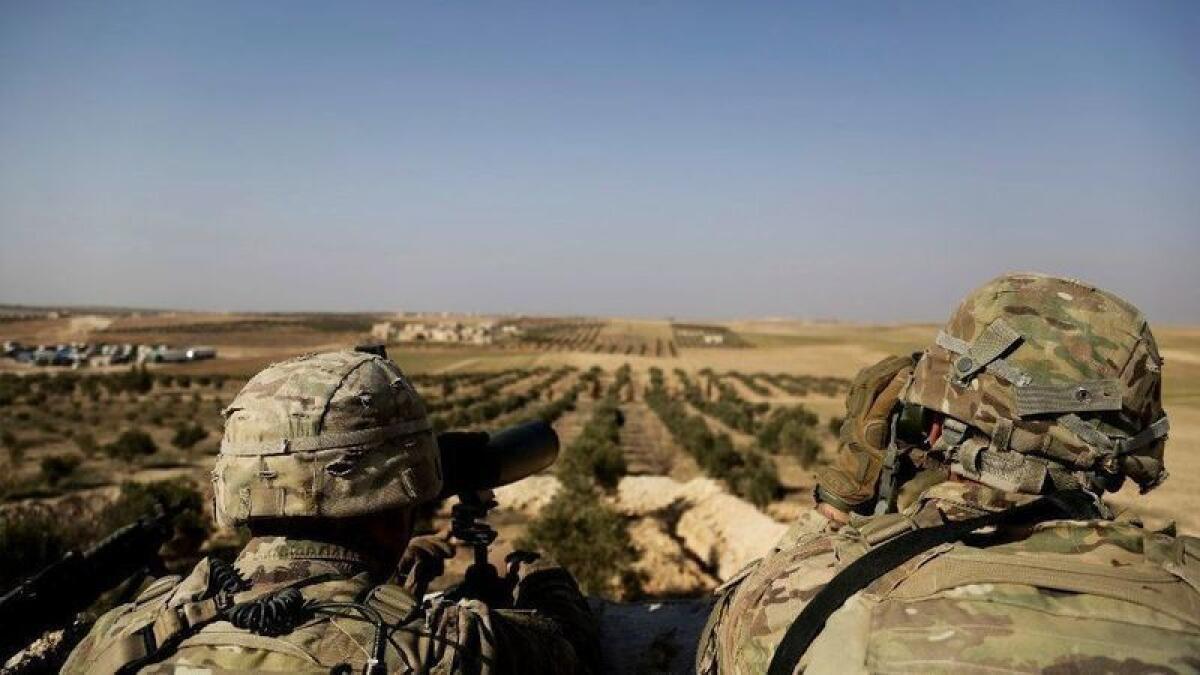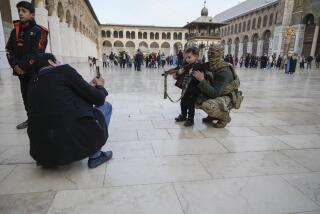Trump still committed to Syria troop withdrawal, despite mixed signals

Reporting from Washington — President Trump’s already confusing policies toward Syria have become even more difficult to parse, both in Washington and in the region convulsed by nearly eight years of civil war, after a flurry of contradictory statements over the last 72 hours.
On Sunday, Trump met with Sen. Lindsey Graham (R-S.C.), a vocal critic of the president’s plan to pull troops out of Syria. After the meeting, Graham said he “felt a lot better” about the situation, describing the withdrawal plan as being “in a pause situation.”
Graham later outlined three conditions he said Trump had set down for a full withdrawal: permanent destruction of the Islamic State militants; protection for Syria’s Kurds, whose militias have been the main U.S. ally in the fight against Islamic State; and curbs on Iran. Those requirements would be extremely difficult to meet.
On Monday, Trump tweeted praise for himself, claiming he should be getting more plaudits for the decision to pull out — a move that has spooked Republican foreign policy hawks and prompted Defense Secretary James N. Mattis’ sudden resignation.
In his tweets, the president alluded for the first time to a timetable that could be slower than the 30-day withdrawal he first suggested.
“If anybody but Donald Trump did what I did in Syria, which was an ISIS loaded mess when I became President, they would be a national hero,” Trump wrote, referring to Islamic State.
“ISIS is mostly gone, we’re slowly sending our troops back home to be with their families, while at the same time fighting ISIS remnants......”
According to multiple administration officials, however, neither Graham’s comments nor Trump’s tweet mean that the president is abandoning his plan to withdraw the 2,000 U.S. troops from Syria.
What remains unsettled is how and when the withdrawal will take place, matters that national security advisor John R. Bolton will take up with the leaders of Israel and Turkey when he travels to the region for meetings this week. The administration’s special representative for Syria, James Jeffrey, is scheduled to accompany Bolton.
In the region, meanwhile, all the warring factions already have begun repositioning themselves for a Syria without the United States — while keeping an eye on the mixed signals from Washington.
Iran, which sees Syria as a crucial link to its allies in Lebanon, stands to gain from having U.S. forces out of the area. Its officials expressed satisfaction with Trump’s move.
A U.S. withdrawal will lead to “strengthening stability in the region,” Maj. Gen. Mohammad Bagheri, the Iranian armed forces chief of staff, said.
“America’s withdrawal from Syrian territories is a humiliating retreat for Washington, which had put its forces in Syria without the permission of its government or people,” he said.
“Americans cause chaos everywhere they go,” he added.
By contrast, America’s main ally in the Syrian fighting, the Kurdish militia groups, have much to fear.
Under U.S. protection, the Kurds have carved out a de facto state covering a large swath of northern and eastern Syria, territory that includes roughly 90% of the country’s gas as well as essential water and hydroelectric resources.
But they fear attack from Turkey, which is also a U.S. ally, but which sees the Kurds as a national security threat because of the large Kurdish minority in its territory.
The Kurdish areas are now under threat from all sides, which has caused Kurdish militia leaders to move closer to Syria’s president, Bashar Assad, who is allied with Iran and Russia and whose forces the U.S. has fought.
Protecting the Kurds has been a chief concern for U.S. military officials and for Graham.
After his meeting Sunday, Graham suggested that Trump would slow down the withdrawal to make sure the Kurds were not harmed.
“I think we’re in a pause situation where we are reevaluating what’s the best way to achieve the president’s objective of having people pay more and do more,” Graham said, referring to Trump’s call for Middle Eastern countries to pay the cost of rebuilding Syria after nearly a decade of war.
The meeting allowed both Graham and Trump some degree of political cover — a chance for the senator to dial back his harsh criticism of Trump’s policy and for the president to appear more measured and strategic after reports that he had impulsively agreed to the troop withdrawal in a phone call in mid-December with Turkish President Recep Tayyip Erdogan, shocking his own advisors.
But the vague statements from both camps created additional confusion about the administration’s intentions, which are often subject to uncertainty and second-guessing given Trump’s penchant for blustery, sometimes self-contradicting statements.
“It’s more that Trump is assuring him that there is a plan and less that there is a change to the idea that troops are coming out,” said Jim Hanson, a Trump ally and president of the Security Studies Group think tank.
Trump’s surprise announcement shortly before Christmas of a withdrawal from Syria came in the form of a tweeted declaration of victory over Islamic State and then a video message from the Rose Garden. Since then, advisors from the Pentagon and the National Security Council have been briefing the president on various options for engineering the pullout, administration officials said.
One such meeting took place on Air Force One last week as the president flew home after making an unannounced visit to U.S. troops stationed in Iraq, a U.S. official said, speaking on condition of anonymity because he was not authorized to discuss the topic on the record.
In GOP national security circles, some are unconvinced by Graham’s rhetoric reversal and, like Mattis and other outspoken former generals, remain frustrated with the president’s decision to withdraw forces from Syria, no matter how slowly it may be carried out.
“It’s still a disaster, no matter how they try and present it,” said one senior Republican national security advisor on Capitol Hill, who was also not authorized to comment by name.
Already, the impact can be seen on the ground. Last week, after Trump’s initial announcement, Kurdish fighters invited the Syrian army to move into their positions in the northern Syrian city of Manbij.
By Monday, government troops had advanced to Manbij’s outskirts, but no farther, apparently to avoid clashes with U.S. forces, according to the Syrian Observatory for Human Rights, a pro-opposition watchdog group.
The pending U.S. withdrawal has also caused a warming of ties between Assad’s government in Syria and officials in Iraq, its neighbor to the east.
Iraqi Prime Minister Adel Abdul Mahdi, whom Trump did not meet on his trip last week to Iraq, said Sunday that he was dispatching a delegation to Damascus to ramp up coordination between the two countries’ forces battling the remaining pockets of Islamic militants along their shared border.
The two countries are also agreeing to cross-border airstrikes by their respective warplanes, officials said, with the first such strike occurring Monday, according to Iraqi state media.
With the U.S. withdrawing, Abdul Mahdi said, Iraq has to “take the initiative and not just receive the results.”
Stokols reported from Washington and Bulos from Amman, Jordan. Times staff writers Tracy Wilkinson and Noah Bierman in Washington contributed to this report.
More to Read
Get the L.A. Times Politics newsletter
Deeply reported insights into legislation, politics and policy from Sacramento, Washington and beyond. In your inbox three times per week.
You may occasionally receive promotional content from the Los Angeles Times.











